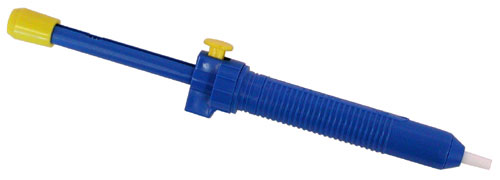- Fri Jun 25, 2010 10:36 am
#103842
Lately I had to make a few ... "revisions" ... to one of my PCBs that required desoldering a number of components. This is very easy when using SMD devices either with hot air or solder wick. However, I'm having a devil of a time doing it with through hole components. It was one thing when I used to work with single-sided boards without plated through holes, but these double-sided boards with plated through holes are much more difficult.
I tried using solder wick, which cleans up the pad nicely, quickly removing all visible solder from both sides in one shot. However, there's always just enough solder left in the plated hole to stick each pin of the component. The usual result is one hand fighting to pry the component off with a lever or a pliers while the other hand quickly tries to heat the pins. I had to remove some TO-220 devices which were a bit tight in the plated holes to start with, and one of them stubbornly ripped off the pads and the plated through hole with it.
So, my question is... Is there any helpful technique or tools? I'm using high-quality desoldering wick that has served me well everywhere else. I have a SMD hot air rework station available, although I did not try it (I'm thinking maybe next time use hot air to try to heat the whole component).
Do the vacuum-operated desoldering stations work better than desoldering wick? In particular, I've considered upgrading my aging Xytronic iron with something like this: http://www.howardelectronics.com/xytronic/lf8800.html, but don't want to spend the extra money for a desoldering station if it's no better than desoldering wick.
Thanks,
Scott
I tried using solder wick, which cleans up the pad nicely, quickly removing all visible solder from both sides in one shot. However, there's always just enough solder left in the plated hole to stick each pin of the component. The usual result is one hand fighting to pry the component off with a lever or a pliers while the other hand quickly tries to heat the pins. I had to remove some TO-220 devices which were a bit tight in the plated holes to start with, and one of them stubbornly ripped off the pads and the plated through hole with it.
So, my question is... Is there any helpful technique or tools? I'm using high-quality desoldering wick that has served me well everywhere else. I have a SMD hot air rework station available, although I did not try it (I'm thinking maybe next time use hot air to try to heat the whole component).
Do the vacuum-operated desoldering stations work better than desoldering wick? In particular, I've considered upgrading my aging Xytronic iron with something like this: http://www.howardelectronics.com/xytronic/lf8800.html, but don't want to spend the extra money for a desoldering station if it's no better than desoldering wick.
Thanks,
Scott

